Intel Core Duo: AOpen i975Xa-YDG to the Rescue
by Gary Key on May 4, 2006 8:00 AM EST- Posted in
- Motherboards
Video Encoding Performance
A traditional weak spot of the current Intel mobile processor offerings has been in the media encoding area when compared to AMD. Considering the main optimizations for the Core Duo centered on media encoding performance, we were very interested in seeing how this platform compared to current AMD lineups. We are utilizing an updated video encoding test suite for this article that includes AnyDVD, Nero Recode 2, Videora, Windows Media Encoder 9, and DivX 6.2.1. One video application missing is QuickTime PRO 7; we utilized it extensively on both test platforms but we ran into issues transcoding our sample video files during the overclocking testing. This is an issue we are currently addressing and hopefully we will be able to post results shortly.Our first test is quite easy - we take our original The Sum of All Fears DVD and use AnyDVD Ripper to copy the full DVD to the hard drive without compression, thus providing an almost exact duplicate of the DVD. We then fired up Nero Recode 2, selected our Sum of All Fears copy on the hard drive, and performed a shrink operation to allow the entire movie along with extras to fit on a single 4.5GB DVD disc. We left all options on their defaults except we checked off the advanced analysis option. The scores reported include the full encoding process and are represented in minutes, with lower numbers indicating better performance.
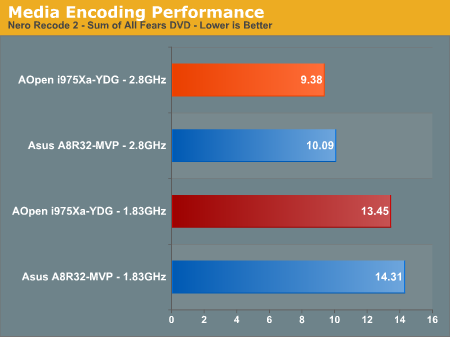
The results are very interesting as we did not expect the Intel system to perform this well. We were so surprised that we ran the test several times and verified our settings before accepting the test results. We guess the last few years of NetBurst results have tainted our cognitive abilities.
Our next test has us extracting Chapter 9 of our movie which will be used extensively in the rest of our benchmarks. After extraction we utilize AutoGK version 2.27 and DivX 6.2.1 to convert our .VOB file into a more accessible .AVI file. We utilize our standard settings and then let this program combination do its magic. We are reporting the numbers in two charts with frames per second and the time in minutes/seconds to complete the conversion.
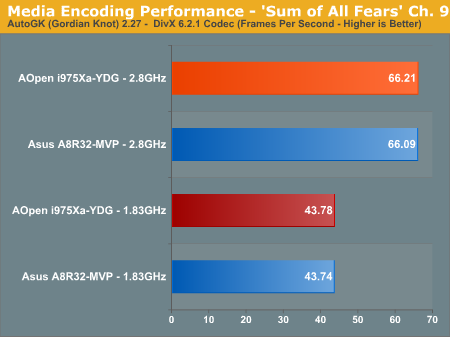
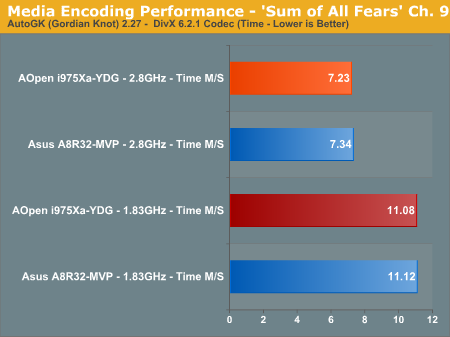
Unlike our Nero Recode 2 test results, this exercise has both systems performing equally. It either means this software is not optimized for a particular platform or the process is equally demanding on both systems.
Next on the list is the Windows Media Encoder 9 test that will convert our newly created .AVI file into a plasma screen pleasing WMV-HD format. We ensured our quality settings were set to High Definition. The values reported are in minutes/seconds for the conversion time, with lower numbers being better.
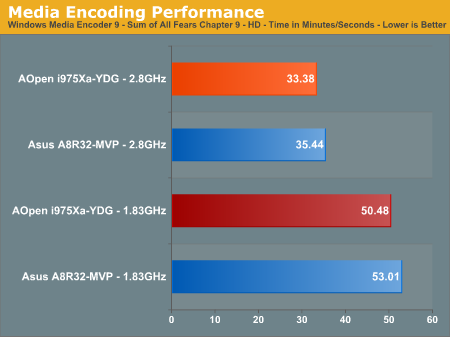
Once again, the Core Duo and the Opteron are close in the benchmark scores with the Intel platform performing up to 6% better in this benchmark. While both platforms are extremely competitive in this benchmark, the AOpen board clearly has the advantage in our scores.
Our final video tests utilize the Videora Converter products to perform a conversion of our Sum of All Fears Chapter 9 .VOB into the proper video format that our Xbox360, iPod, and Sony Playstation Portable can understand. We utilized the default settings for each program and have reported the results in minutes/seconds with the lower numbers being better. The final results show the transcoding process times for converting our standard 327MB file into a 43.2MB file for iPod, 111MB file for Xbox 360, and a 66MB file for PSP.
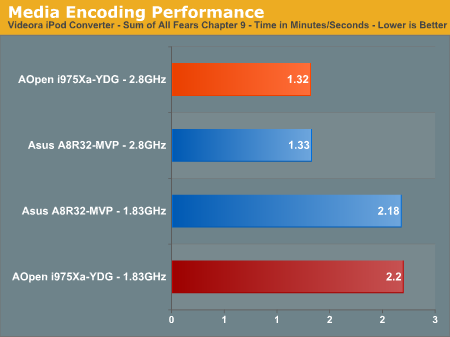
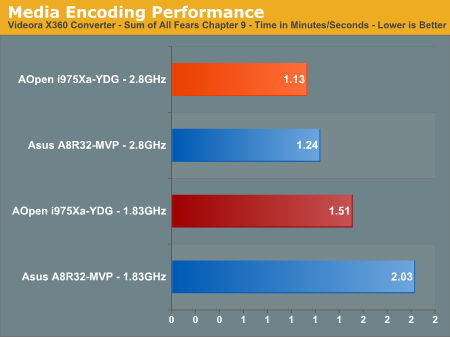
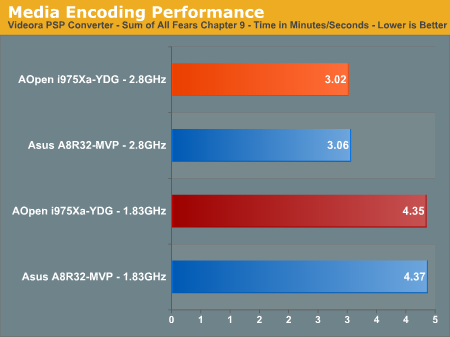
In these particular benchmarks both platforms are basically even with a minimal advantage going to the Intel platform in the more demanding Xbox 360 conversion. These results continue the pattern of the Intel Core Duo platform not being at a distinct disadvantage when compared to the current AMD offerings and actually having an advantage in most instances. Intel users can begin to rejoice now - just no dancing in the streets until the next product release please.










81 Comments
View All Comments
Gary Key - Friday, May 5, 2006 - link
Sorry, being a selfish s.o.b. with this drive, actually I am testing two of them for an upcoming article. :)
sabrewulf - Thursday, May 4, 2006 - link
I haven't been following the development of Conroe too closely, but isn't this chip essentially performing like Conroe will? Or am I missing something?Some of the tests were impressive, but the gaming tests were certainly not "20-40%" improvement over AMD like everyone is wishing.
MrKaz - Thursday, May 4, 2006 - link
And "will" never be.Don’t forget Intel was using:
- Some special ATI driver.
- Crossfire setup (maybe modified),
20%~40% that you will never get, unless you have such kind of configuration.
On non SLI/Crossfire configuration will never be higher than 5%, 10% improvement...
And thanks that a lot to the 4MB cache, and minor processor (P3 redesign) changes.
Don’t forget that the Intel dual core with 4MB shared cache can act as one BIG single core processor with 4MB cache and the second core with 0MB of cache for the extra “stupid” calc...
IntelUser2000 - Thursday, May 4, 2006 - link
LOL. I always doubt that people can be such a dumb fanboy even I see them over and over again in time.
How do you explain Xtremsystems benchmark, and all the architectural advantages?? Did Netburst's poor showing really blind you??
MrKaz - Friday, May 5, 2006 - link
Fun boy me?It's you who calls him self by the stupid nick name Inteluser2000.
Some time there are complete morons here and you are one of them.
ME the "fan boy" has to "defend" Intel, a thing that you with your little brain can’t do.
Read my reply to your fan boy friends, there you will find why conroe will be good, and it's not because it's Intel.... dumb moron....
redbone75 - Thursday, May 4, 2006 - link
I don't think it was a "special" driver per se, if I recall the driver had some changes made in order to recognize Conroe.
I just love how a lot of people refer to Conroe as a P3 redesign as if it's something so bad. No, it's not a P3 redesign, there are elements of what made the P3 so successful incorporated into the chip, but that's not what makes the chip so awesome. Also, so what if it is ultimately just a "P3 redesign" as you put it? You use what works, and obviously this works. Hey, the K7 core was pretty good, and K8 is so well designed that AMD can ride it for a few more years.
MrKaz - Friday, May 5, 2006 - link
"in order to recognize Conroe"Why they need to recognize Conroe?
-Would work?
-Did work but with inferior performance?
-Special optimizations?
-New instruction set (SSE4) support for improved performance?
Questar - Thursday, May 4, 2006 - link
Wow, some fanboys are still in denial.This is an interim MOBILE chip that just put the smack down on an Opteron. What's going to happen when the real thing comes out?
MrKaz - Friday, May 5, 2006 - link
When the real thing come out? That’s easy:Core duo plus:
- 2MB cache (+5%~10%)
- 2X FSB (+4%~8%)
- 800Mhz DDR2 (3%~6%)
- x64 support (0%)
- Higher clock speed 2.1Ghz to 3.3Ghz (anyone can say 50% performance increase?)
I’m not a fan boy, it’s you Intel stupid morons that can even read and make some thought why should Conroe be faster than AMD Athlon 64….
Go back and reread the article about:
Intel Core versus AMD's K8 architecture
Don’t expect conroe be very different from core duo... I’m not saying that’s bad…
Questar - Friday, May 5, 2006 - link
You forgot a couple of things:Addidtional ALU Unit
Twice the SSE performace
Better code reordering
Larger reservation station
New micro-ops